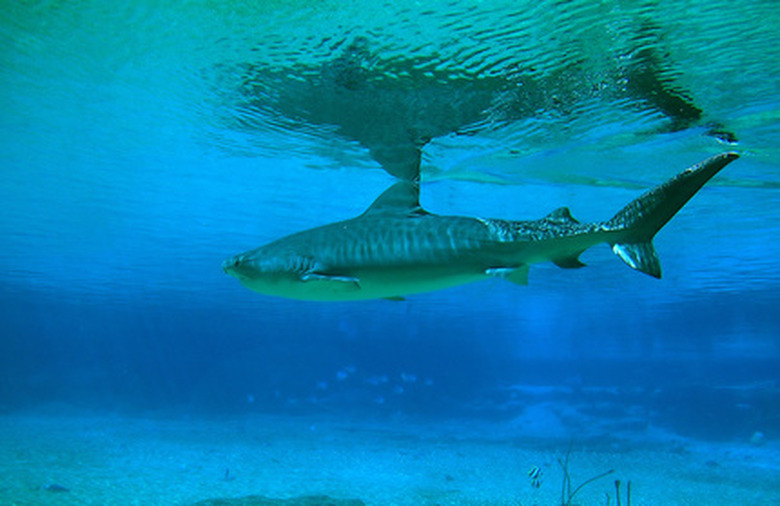Life Cycle Of A Shark
Sharks are some of the oldest creatures on the planet. According to the Canadian Shark Research Laboratory, sharks have lived in the waters for over 400 million years. That is well before the rise and fall of dinosaurs and other prehistoric creatures.
Although movies may paint them in a frightening light, sharks offer benefits to the planet by controlling marine life populations. Humans also benefit from products from sharks, such as shark liver extract, which can be used as machine oil.
In this post, we're going over the shark life cycle, whether sharks lay eggs and other shark facts.
Fertilization and Gestation
Fertilization and Gestation
Shark eggs remain inside the female, waiting for fertilization. LookD.com describes how a male shark can fertilize the eggs with his pelvic fin, which has developed into an organ to deliver sperm to the female's body.
Three types of sharks exist and, in two of these types, the eggs remain inside the mother shark for a period between nine and 22 months for gestation. Because of this, many shark species only give birth every two years, explains the NOAA.
Internal Gestation
Internal Gestation
Viviparous sharks, including hammerheads and whale sharks, give birth to live shark babies, similar to mammals such as humans, instead of having those sharks lay eggs. Like a human embryo, the baby sharks receive nutrients inside the womb from an umbilical cord. The baby sharks also receive oxygen from the mother shark's bloodstream via the placenta.
Great whites and tiger sharks are a type of shark known as ovoviviparous. Like viviparous sharks, the fertilized eggs remain inside the mother. However, these eggs also hatch into baby sharks, or pups, inside the mother. So while some sharks do have eggs internally, we don't say that those sharks lay eggs.
However, not all eggs hatch and the baby sharks will eat the unfertilized eggs for strength and nutrients. Some baby sharks may even eat their siblings after eating the unfertilized eggs. The result of this is small shark litters.
External Incubation
External Incubation
The Enchanted Learning website illustrates how oviparous sharks deposit eggs into the ocean rather than internally incubating the eggs. These eggs feature a tough, leather-like membrane that protects them from predators because neither parent guards the eggs. Because of this, shark eggs are vulnerable to predators.
These eggs are similar to eggs of chickens and contain a nutrient-rich yolk that feeds the embryo. Catshark eggs have tendrils with which the eggs attach themselves to the ocean floor or sea bed. Other shark species that deposit shark eggs include zebra sharks and hornsharks.
Shark Life Cycle Starts: Birth
A shark mother births baby sharks known as pups. Shark litters can be quite small and some species may only birth two pups. However, it is not uncommon for shark litters to contain between nine and 14 pups. Certain species, such as the blue shark and whale shark, have been known to have litters of as many as 100 pups.
Baby sharks look quite similar to grown sharks, only smaller. For example, great white shark pups weigh approximately 40 pounds at birth and have a length of four to five feet.
Immediately after birth, shark pups leave their mother and survive on their own, possibly due to the threat that the mother shark will attack. Pups are able to survive because shark they are born with natural survival knowledge and a full set of teeth.
Growth
Growth
While sharks may leave the mother, some species do not go far, as illustrated by a 14-year study that made the cover of "Molecular Ecology" journal.
Demian Chapman, a shark scientist with the Institute for Ocean Conservation Science at Stony Brook University, explains in the article how many lemon sharks stay near their place of birth during their "tween" and teen years.
Because of this, shark populations can suffer as coastal development kills both baby sharks and young sharks who have not yet reached maturity.
Adulthood
Adulthood
Many types of sharks have a life expectancy of 20 to 30 years, and some species of sharks can take up to 18 years to fully mature. Adult sharks vary in size and weight because there are over 250 different shark species.
The largest types of sharks, the whale shark, can reach almost 40 feet in length while the smallest shark, the dwarf shark, is only 10 inches long.
Cite This Article
MLA
Martinez, Nicole. "Life Cycle Of A Shark" sciencing.com, https://www.sciencing.com/life-cycle-shark-6723691/. 22 November 2019.
APA
Martinez, Nicole. (2019, November 22). Life Cycle Of A Shark. sciencing.com. Retrieved from https://www.sciencing.com/life-cycle-shark-6723691/
Chicago
Martinez, Nicole. Life Cycle Of A Shark last modified March 24, 2022. https://www.sciencing.com/life-cycle-shark-6723691/
